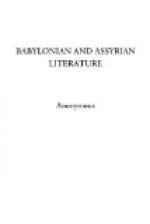[Footnote 1: “O Moon-god, hear my cry!” ("Siu lici unnini!”) the name of the author of the Izdubar epic upon which our poem is based.]
[Footnote 2: “Khar-sak-kur-ra,” the Deluge mountain on which the ark of Khasisadra (the Accadian Noah) rested.]
[Footnote 3: “Khar-sak-kal-ama” is a city mentioned in the Izdubar epic, and was probably situated at the base of Khar-sak-kur-ra, now called Mount Elwend. The same mountain is sometimes called the “Mountain of the World” in the inscriptions, where the gods were supposed to sometimes reside.]
[Footnote 4: “Pit-u-dal-ti,” openers of the gates.]
[Footnote 5: “Masari,” guards of the great gates of the city, etc.]
[Footnote 6: “Ellat-gula,” the queen of Erech, the capital of Babylonia.]
[Footnote 7: “Tur-tan-u” was the army officer or general who in the absence of the sovereign took the supreme command of the army, and held the highest rank next to the queen or king.]
[Footnote 8: “Dannat” (the “Powerful Lady”) was a title applied to the Queen, the mother of Izdubar (Sayce’s ed. Smith’s “Chal. Acc. of Gen.,” p. 184). We have here identified her with Ellat-gula, the Queen of Babylon, who preceded Ham-murabi or Nammurabi, whom the inscriptions indicate was an Accadian. The latter we have identified with Nimrod, following the suggestion of Mr. George Smith.]
[Footnote 9: “Khumbaba” was the giant Elamitic king whom Izdubar overthrew. We identify him with the King of the Elamites who, allied with Rimsin or Rimagu, was overthrown by Nammurabi or Izdubar.]
[Footnote 10: “Rim-siu,” above referred to, who overthrew Uruk, or Karrak, or Erech. He was King of Larsa, immediately south of Erech.]
[Footnote 11: “Nap-pa-khu,” war-trumpet.]
[Footnote 12: “Bar-ru,” army officer.]
[Footnote 13: “Samas,” the sun-god.]
[Footnote 14: “Subartu” is derived from the Accadian “subar” ("high"), applied by the Accadians to the highlands of Aram or Syria. It is probable that all these countries, viz., Subartu, Goim, Lullubu, Kharsak-kalama, Eridu, and Duran, were at one time inhabited by the Accadians, until driven out by the Semites.]
[Footnote 15: “Sutu” is supposed to refer to the Arabians.]
[Footnote 16: “Kassi,” the Kassites or Elamites. The Kassi inhabited the northern part of Elam.]
[Footnote 17: “Goim,” or “Gutium,” supposed by Sir Henry Rawlinson to be the Goyim of Gen. xiv, ruled by Tidal or Turgal ("the Great Son").]
[Footnote 18: “Lul-lu-bu,” a country northward of Mesopotamia and Nizir.]
[Footnote 19: “Kharsak-kala-ma,” the city supposed to lie at the base of Kharsak-kurra, or Mount Nizir, or Mount Elwend. The same city was afterward called Echatana.]
[Footnote 20: “Eridu,” the land of Ur, or Erech.]
[Footnote 21: “Duran,” Babylonia.]




